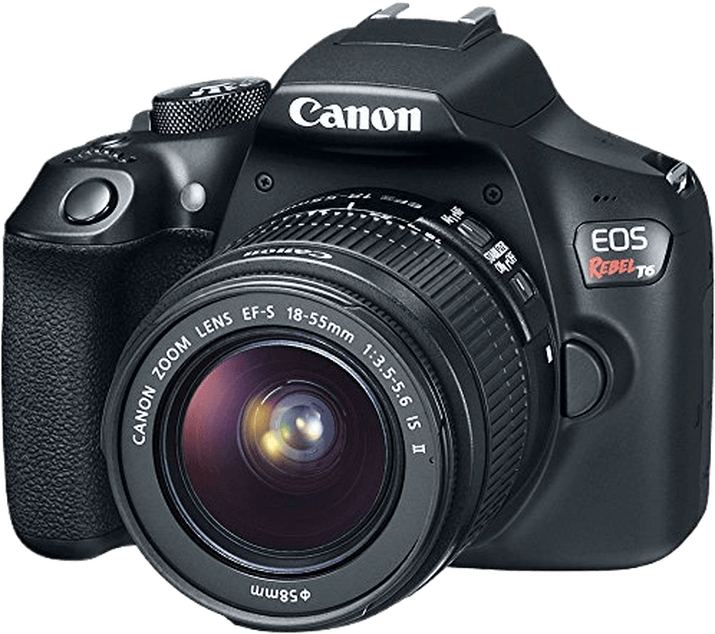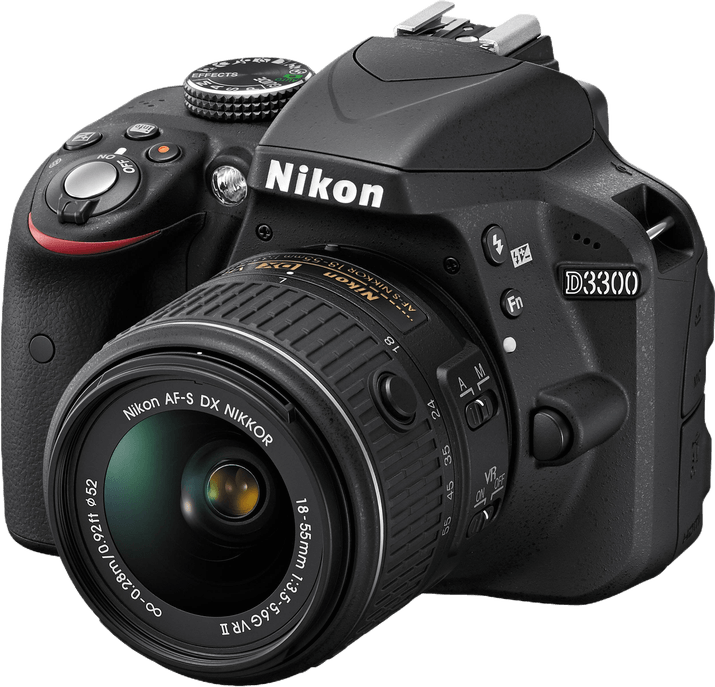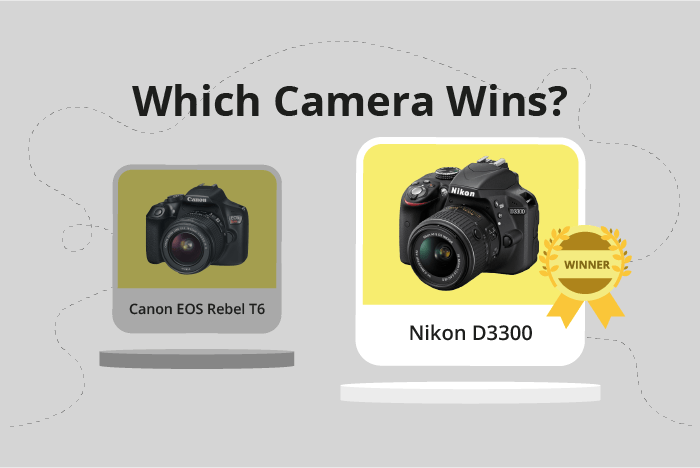Canon EOS Rebel T6 / 1300D vs Nikon D3300 Comparison
Canon EOS Rebel T6 / 1300D

Nikon D3300

The Nikon D3300 outperforms the Canon EOS Rebel T6 / 1300D with a score of 55/100 compared to Canon’s 39/100. Both cameras are DSLRs, released in 2014 and 2016, and initially priced at $650 and $550, respectively. They share similar dimensions, with the Nikon D3300 being slightly smaller and lighter at 124 x 98 x 76mm and 430g, compared to the Canon’s 129 x 101 x 78mm and 485g.
The Nikon D3300’s higher score reflects its superior performance and features. However, the Canon EOS Rebel T6 / 1300D’s lower price makes it a more budget-friendly option for those looking for an entry-level DSLR. Ultimately, the Nikon D3300 offers better value for its price, while the Canon EOS Rebel T6 / 1300D is a decent choice for those on a tighter budget.
Canon EOS Rebel T6 / 1300D vs Nikon D3300 Overview and Optics
The Nikon D3300 outperforms the Canon EOS Rebel T6 / 1300D in optics, scoring 64/100 compared to the Canon’s 40/100. Both cameras share certain specifications, such as having a CMOS sensor, APS-C sensor size, and no image stabilization. Additionally, they use their respective brand’s lens mounts: Canon EF-S for the Rebel T6 and Nikon F DX for the D3300.
The Nikon D3300’s higher score is due to its superior specifications. It boasts 24.2 megapixels, a faster shooting speed of 5 frames per second, and an Expeed 4 processor. Furthermore, the Nikon has a higher DXOMARK sensor score of 82, which contributes to better image quality.
On the other hand, the Canon Rebel T6 has 18 megapixels, a slower shooting speed of 3 frames per second, and a Digic 4+ processor. Its DXOMARK sensor score is lower at 66, indicating that its image quality is not as impressive as the Nikon D3300’s. The Canon does not have any specific advantages in optics over the Nikon.
To conclude, the Nikon D3300 is the better choice for those seeking superior optics. Its higher megapixel count, faster shooting speed, and more advanced processor result in a higher score and better image quality. The Canon EOS Rebel T6 / 1300D, while sharing some common specifications with the Nikon, falls short in key areas that contribute to its lower score.
Canon EOS Rebel T6 / 1300D vs Nikon D3300 Video Performance
The Nikon D3300 outperforms the Canon EOS Rebel T6 / 1300D in video capabilities with a video score of 56 to 43. Both cameras share common specifications, including Full HD video resolution and maximum video dimensions of 1920 x 1080. Neither camera has built-in time-lapse functionality.
The Nikon D3300’s superior video score is primarily due to its higher maximum video frame rate of 60fps, which is double the Canon T6’s 30fps. This increased frame rate allows for smoother video playback and improved slow-motion capabilities, lending the D3300 an advantage in capturing fast-moving subjects or creating more cinematic footage.
On the other hand, the Canon T6 does not offer any significant advantages over the Nikon D3300 in terms of video capabilities. Both cameras lack time-lapse functionality, and the T6’s lower maximum frame rate of 30fps limits its flexibility in comparison to the D3300.
In comparing these two cameras, the Nikon D3300 is the better option for video recording due to its higher frame rate. While both cameras offer Full HD resolution and lack time-lapse functionality, the D3300’s 60fps capability makes it more versatile and suitable for various video applications. The Canon T6, despite being a competent camera for still photography, falls short in this particular aspect of video performance.
Canon EOS Rebel T6 / 1300D vs Nikon D3300 Features and Benefits
The Canon EOS Rebel T6 / 1300D and Nikon D3300 both have a feature score of 41 out of 100. Despite having the same score, these cameras have distinct features that set them apart.
Both cameras have a 3-inch screen, with the Canon T6 having a resolution of 920,000 dots and the Nikon D3300 with a slightly higher resolution of 921,000 dots. Neither camera has a touchscreen or GPS. The Canon T6 has a flip screen, while the Nikon D3300 does not. Additionally, the Canon T6 has built-in Wi-Fi, but it lacks Bluetooth. In contrast, the Nikon D3300 has no Wi-Fi or Bluetooth connectivity.
The Canon T6 stands out with its flip screen, which allows for more flexible shooting angles. This feature is particularly useful for capturing images at difficult angles and for shooting self-portraits. The built-in Wi-Fi allows for easy sharing of images and remote control of the camera.
On the other hand, the Nikon D3300 has a slightly higher screen resolution than the Canon T6. Although the difference is minimal, this can result in a slightly clearer display. However, the Nikon D3300 does not have any other significant advantages over the Canon T6 in terms of features.
Both cameras have their unique features, but the Canon T6 offers more versatility with its flip screen and Wi-Fi connectivity. The Nikon D3300’s slightly higher screen resolution is not enough to outweigh these advantages. Therefore, the Canon T6 is the better option when considering features.
Canon EOS Rebel T6 / 1300D vs Nikon D3300 Storage and Battery
The Nikon D3300 emerges as the winner in storage and battery with a score of 32/100, while the Canon EOS Rebel T6 / 1300D trails with a score of 27/100. Both cameras share similarities in their storage specifications, having a single memory card slot and accepting SD, SDHC, and SDXC cards. Neither camera supports USB charging.
The Nikon D3300 surpasses the Canon T6 in battery performance, offering a longer battery life of 700 shots compared to the T6’s 500 shots. This advantage allows users to take more photos before needing to replace or recharge the battery. The Canon T6, however, does not have any notable advantages over the Nikon D3300 in storage and battery.
Considering these factors, the Nikon D3300 proves to be the better choice for photographers who prioritize longer battery life and uninterrupted shooting sessions.
Alternatives to the Canon EOS Rebel T6 / 1300D and Nikon D3300
Are you still undecided about which camera is right for you? Have a look at these popular comparisons that feature the Canon EOS Rebel T6 / 1300D or the Nikon D3300:

